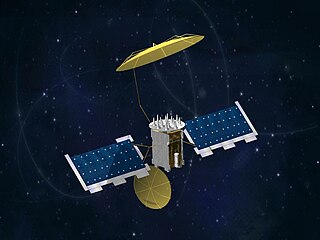
Delta IV was a group of five expendable launch systems in the Delta rocket family. It flew 45 missions from 2002 to 2024. Originally designed by Boeing's Defense, Space and Security division for the Evolved Expendable Launch Vehicle (EELV) program, the Delta IV became a United Launch Alliance (ULA) product in 2006. The Delta IV was primarily a launch vehicle for United States Air Force (USAF) military payloads, but was also used to launch a number of United States government non-military payloads and a single commercial satellite.

The Mobile User Objective System (MUOS) is a United States Space Force narrowband military communications satellite system that supports a worldwide, multi-service population of users in the ultra high frequency (UHF) band. The system provides increased communications capabilities to newer, smaller terminals while still supporting interoperability with legacy terminals. MUOS is designed to support users who require greater mobility, higher bit rates and improved operational availability. The MUOS was declared fully operational for use in 2019.

United Launch Alliance, LLC, commonly referred to as ULA, is an American aerospace manufacturer, defense contractor and launch service provider that manufactures and operates rockets that launch spacecraft into Earth orbit and on trajectories to other bodies in the Solar System. ULA also designed and builds the Interim Cryogenic Propulsion Stage for the Space Launch System (SLS).

Advanced Extremely High Frequency (AEHF) is a constellation of communications satellites operated by the United States Space Force. They are used to relay secure communications for the United States Armed Forces, the British Armed Forces, the Canadian Armed Forces, the Netherlands Armed Forces and the Australian Defence Force. The system consists of six satellites in geostationary orbits. The final satellite was launched on 26 March 2020. AEHF is backward compatible with, and replaces, the older Milstar system and will operate at 44 GHz uplink and 20 GHz downlink. The AEHF system is a joint service communications system that provides survivable, global, secure, protected, and jam-resistant communications for high-priority military ground, sea and air assets.

USA-195, or Wideband Global SATCOM 1 (WGS-1) is a United States military communications satellite operated by the United States Air Force as part of the Wideband Global SATCOM programme. Launched in 2007, it was the first WGS satellite to reach orbit. It is stationed at a longitude of 174.8° East.

USA-233, or Wideband Global SATCOM 4 (WGS-4) is a United States military communications satellite operated by the United States Air Force as part of the Wideband Global SATCOM program, launched in 2012. The fourth Wideband Global SATCOM satellite, it is the first WGS Block II satellite to be launched. It is stationed at 88.5° East in geostationary orbit.

USA-243, also known as WGS-5, is a United States military communications satellite. It was the fifth satellite to be launched as part of the Wideband Global SATCOM program and the second Block II satellite.

USA-204, or Wideband Global SATCOM 2 (WGS-2) is a United States military communications satellite which is operated by the United States Air Force as part of the Wideband Global SATCOM programme. Launched in 2009, it was the second WGS satellite to reach orbit, and operates in geostationary orbit at a longitude of 60° East.

USA 211, or Wideband Global SATCOM 3 is a United States military communications satellite operated by the United States Air Force as part of the Wideband Global SATCOM programme. Launched in 2009, it was the third WGS satellite, and final Block I satellite, to reach orbit. It was originally stationed in geostationary orbit at 12° West.

USA-244, or Wideband Global SATCOM 6 (WGS-6) is a United States military communications satellite operated by the United States Air Force as part of the Wideband Global SATCOM programme. Launched in 2013, it was the sixth WGS satellite to reach orbit. It is stationed at a longitude of 135° West, in geostationary orbit. WGS-6 was procured by the Australian Defence Force for the U.S. Air Force, in exchange for participation in the programme.

USA-251, also known as GPS IIF-6, GPS SVN-67 and NAVSTAR 70, is an American navigation satellite which forms part of the Global Positioning System. It was the sixth of twelve Block IIF satellites to be launched.

USA-263, or Wideband Global SATCOM 7 (WGS-7) is a United States military communications satellite operated by the United States Air Force as part of the Wideband Global SATCOM programme. Launched in 2015, it was the seventh WGS satellite to reach orbit. It is stationed at a longitude of 135° West, in geostationary orbit. WGS-7 was procured by the United States Air Force.

USA 272, or Wideband Global SATCOM 8 is a United States military communications satellite operated by the United States Air Force as part of the Wideband Global SATCOM programme. Launched Delta IV in 2016, it was the eighth WGS satellite to reach (target) orbit. It is stationed at a longitude of 135° West, 149°E i=0° in geostationary orbit. WGS F8 was procured by the United States Air Force.

USA-275, or Wideband Global SATCOM 9 (WGS-9) is a United States military communications satellite operated by the United States Air Force as part of the Wideband Global SATCOM programme. Launched in 2017, it was the ninth WGS satellite to reach orbit. It is stationed at a longitude of 135° West, in geostationary orbit. WGS-9 was procured by the United States Air Force.

USA-291, or Wideband Global SATCOM 10 (WGS-10) is a United States military communications satellite operated by the United States Air Force as part of the Wideband Global SATCOM programme. Launched in 2019, it was the tenth WGS satellite to reach orbit. It is in geostationary orbit. WGS-10 was procured by the United States Air Force.

Wideband Global SATCOM 11+, is a United States military communications satellite to be operated by the United States Space Force as part of the Wideband Global SATCOM Program. Scheduled for 2024, it is the eleventh WGS satellite and is expected to be in geostationary orbit. WGS 11+ was acquired by the United States Air Force.

















